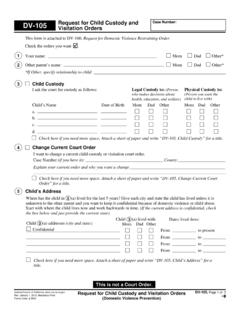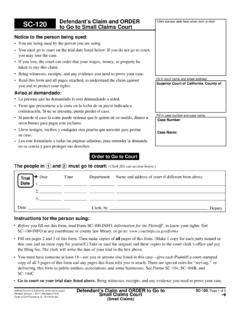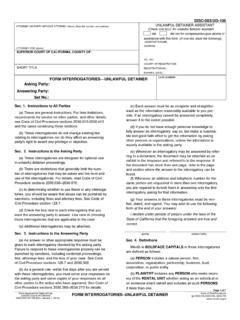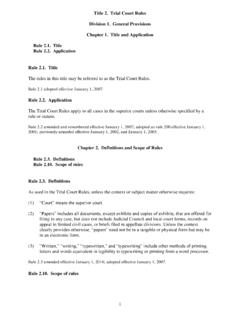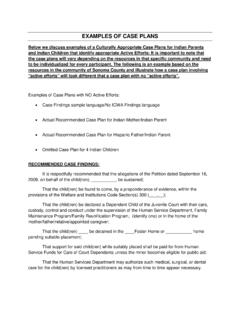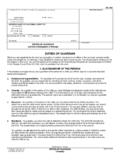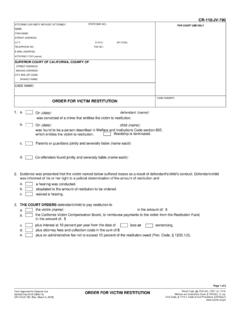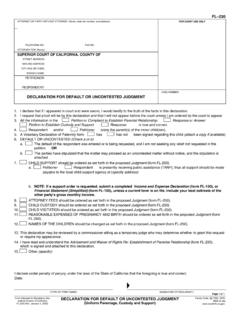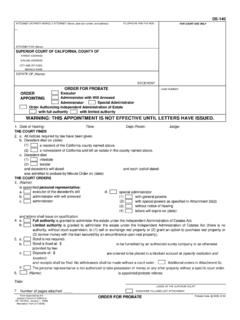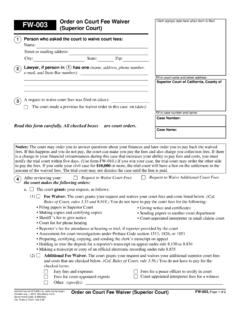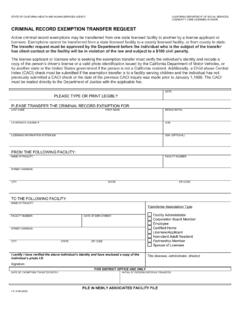Transcription of CACI07-02 Invitation to Comment - California Courts
1 CACI07-02 Invitation to Comment Title Civil Jury Instructions ( caci ) Revisions Summary Revisions to punitive damages instructions ( caci Nos. 3940, 3942, 3943, 3945, 3947, and 3949) required by the United States Supreme court decision in Philip Morris USA v. Williams (2007) -- --, -- [127 1057; 166 940] (2007 LEXIS 1332). The same change is proposed for all six instructions. Source Advisory Committee on Civil Jury Instructions Hon. H. Walter Croskey, Chair Staff Bruce Greenlee, Attorney, 415-865-7698 Attachment CIVIL JURY INSTRUCTIONS ( caci ) SUMMER 2007 REVISIONS TABLE OF CONTENTS DAMAGES SERIES 3940 Punitive Damages Individual Defendant Trial Not 1-7 3942 Punitive Damages Individual Defendant Bifurcated Trial (Second Phase) .. 8-13 3943 Punitive Damages Against Employer or Principal for Conduct of a Specific Agent or Employee Trial Not 3945 Punitive Damages Entity Defendant Trial Not 3047 Punitive Damages Individual and Entity Defendants Trial Not 3949 Punitive Damages Individual and Corporate Defendants (Corporate Liability Based on Acts of Named Individual) Bifurcated Trial (Second Phase).
2 36-41 PRELIMINARY DRAFT ONLY - NOT APPROVED FOR USE BY THE JUDICIAL COUNCIL Copyright 2007 Judicial Council of California 3940. Punitive Damages Individual Defendant Trial Not Bifurcated If you decide that [name of defendant] s conduct caused [name of plaintiff] harm, you must decide whether that conduct justifies an award of punitive damages. The purposes of punitive damages are to punish a wrongdoer for the conduct that harmed the plaintiff and to discourage similar conduct in the future. You may award punitive damages only if [name of plaintiff] proves by clear and convincing evidence that [name of defendant] engaged in that conduct with malice, oppression, or fraud. Malice means that [name of defendant] acted with intent to cause injury or that [name of defendant] s conduct was despicable and was done with a willful and knowing disregard of the rights or safety of another.
3 A person acts with knowing disregard when he or she is aware of the probable dangerous consequences of his or her conduct and deliberately fails to avoid those consequences. Oppression means that [name of defendant] s conduct was despicable and subjected [name of plaintiff] to cruel and unjust hardship in knowing disregard of [his/her] rights. Despicable conduct is conduct that is so vile, base, or contemptible that it would be looked down on and despised by reasonable people. Fraud means that [name of defendant] intentionally misrepresented or concealed a material fact and did so intending to harm [name of plaintiff]. There is no fixed standard for determining the amount of punitive damages, and you are not required to award any punitive damages. If you decide to award punitive damages, you should consider all of the following in determining the amount: (a) How reprehensible was [name of defendant] s conduct?
4 In deciding how reprehensible [name of defendant] s conduct was, you may consider, among other factors: 1. Whether the conduct caused physical harm; 2. Whether [name of defendant] disregarded the health or safety of others; 3. Whether [name of plaintiff] was financially weak or vulnerable and [name of defendant] knew [name of plaintiff] was financially weak or vulnerable and took advantage of [him/her/it]; 4. Whether [name of defendant] s conduct involved a pattern or practice; and 5. Whether [name of defendant] acted with trickery or deceit. (b) Is there a reasonable relationship between the amount of punitive damages and 11 PRELIMINARY DRAFT ONLY - NOT APPROVED FOR USE BY THE JUDICIAL COUNCIL Copyright 2007 Judicial Council of California [name of plaintiff] s harm [or between the amount of punitive damages and potential harm to [name of plaintiff] that [name of defendant] knew was likely to occur because of [his/her/its] conduct]?
5 [Punitive damages may not be used to punish [name of defendant] for the impact of [his/her/its] alleged misconduct on persons other than [name of plaintiff].] (c) In view of [name of defendant] s financial condition, what amount is necessary to punish [him/her] and discourage future wrongful conduct? You may not increase the punitive award above an amount that is otherwise appropriate merely because [name of defendant] has substantial financial resources. [Any award you impose may not exceed [name of defendant] s ability to pay.] New September 2003; Revised April 2004, October 2004, December 2005, June 2006, April 2007, August 2007 Directions for Use CAUTION: The United States Supreme court recently held that the Due Process Clause of the Constitution forbids the award of punitive damages to punish a defendant for injuries caused to nonparties.
6 (Philip Morris USA v. Williams (2007) 549 ___, ___ [127 1057, 166 940] (2007 LEXIS 1332).) This instruction may need to be revised in light of this holding. The advisory committee will be considering revisions for the next release. This instruction is intended to apply to individual persons only. When the plaintiff is seeking punitive damages against corporate defendants, use caci No. 3943, Punitive Damages Against Employer or Principal for Conduct of a Specific Agent or Employee Trial Not Bifurcated, or caci No. 3945, Punitive Damages Entity Defendant Trial Not Bifurcated. When plaintiff is seeking punitive damages against both an individual person and a corporate defendant, use caci No. 3947, Punitive Damages Individual and Entity Defendants Trial Not Bifurcated. For an instruction explaining clear and convincing evidence, see caci No.
7 201, More Likely True Clear and Convincing Proof. Read the bracketed language in subdivisionat the end of the first sentence of factor (b) only if there is evidence that the conduct of defendant that allegedly gives rise to liability and punitive damages either caused or foreseeably threatened to cause harm to plaintiff that would not be included in an award of compensatory damages. (Simon v. San Paolo Holding Co., Inc. (2005) 35 1159 [29 379, 113 63].) The bracketed phrase concerning potential harm might be appropriate, for example, where if damages actually caused by the defendant s acts are not recoverable because they are barred by statute (id. at p. 1176, citing Neal v. Farmers Ins. Exchange (1978) 21 910, 929 [148 389, 582 980] [in a bad faith insurance case, plaintiff died before judgment, precluding her estate s recovery of emotional distress damages]), or where if the harm caused by defendant s acts could have been great, but by chance only slight harm was inflicted.
8 (Simon, supra, 35 at p. 1177, citing TXO Production Corp. v. Alliance Resources Corp. (1993) 509 443, 459 [113 2711, 125 366] [considering the hypothetical of a person wildly firing a gun into a crowd but by chance 22 PRELIMINARY DRAFT ONLY - NOT APPROVED FOR USE BY THE JUDICIAL COUNCIL Copyright 2007 Judicial Council of California only damaging a pair of glasses]). The bracketed phrase should not be given where an award of compensatory damages is the true measure of the harm or potential harm caused by defendant s wrongful acts. (Simon, supra, 35 at pp. 1178 1179 [rejecting consideration for purposes of assessing punitive damages of the plaintiff s loss of the benefit of the bargain where if the jury had found that there was no binding contract]). Read the optional final sentence of factor (b) if there is a possibility that the jury might consider harm the defendant s conduct might have caused to nonparties in arriving at an amount of punitive damages.
9 (See Philip Morris USA v. Williams (2007) -- --, -- [127 1057; 166 940] (2007 LEXIS 1332).) Read the bracketed language in subdivisionoptional final sentence of factor (c) only if the defendant has presented relevant evidence regarding that issue. A jury must be instructed .. that it may not use evidence of out-of-state conduct to punish a defendant for action that was lawful in the jurisdiction where it occurred. (State Farm Mutual Automobile Insurance Co. v. Campbell (2003) 538 408, 422 [123 1513, 155 585].) An instruction on this point should be included within this instruction if appropriate to the facts. In an appropriate case, the jury may be instructed that a false promise or a suggestion of a fact known to be false may constitute a misrepresentation as the word misrepresentation is used in the instruction s definition of fraud.
10 Courts have stated that [p]unitive damages previously imposed for the same conduct are relevant in determining the amount of punitive damages required to sufficiently punish and deter. The likelihood of future punitive damage awards may also be considered, although it is entitled to considerably less weight. (Stevens v. Owens-Corning Fiberglas Corp. (1996) 49 1645, 1661 [57 525], internal citations omitted.) The court in Stevens suggested that the following instruction be given if evidence of other punitive damage awards is introduced into evidence: If you determine that a defendant has already been assessed with punitive damages based on the same conduct for which punitive damages are requested in this case, you may consider whether punitive damages awarded in other cases have sufficiently punished and made an example of the defendant.
